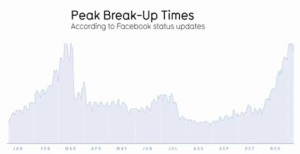 This graph on the right represents break ups per day, as determined by an analysis of Facebook status changes. The data suggests that break-ups seem to occur most frequently in mid-February and late November.
This graph on the right represents break ups per day, as determined by an analysis of Facebook status changes. The data suggests that break-ups seem to occur most frequently in mid-February and late November.
Drawing conclusions from data is always dicey, and there are probably a lot of holes to poke in the methodology here, but it certainly is fun trying to attach meaning to these numbers!
This graph was featured in a TED Talk given by David McCandless, who runs the wonderful website www.informationisbeautiful.net.
The whole talk can be found here; this chart comes up at around the 6:50 mark.
The amount of data available through social networking sites is mindblowing, and it can’t be long before it will be used in some significant way. Indeed, a group of MIT students has already devised a system, cleverly titled Project Gaydar, that, with some accuracy, identifies the sexual orientation of a Facebook user based on friends, likes, and other connections.
What will they compute about us next?



